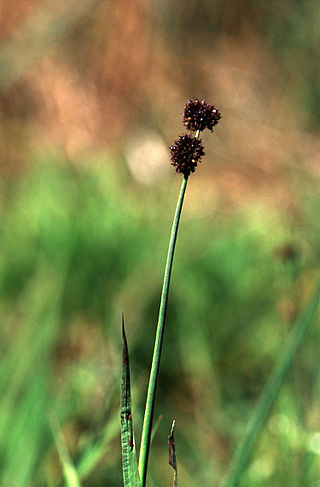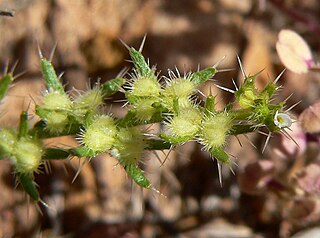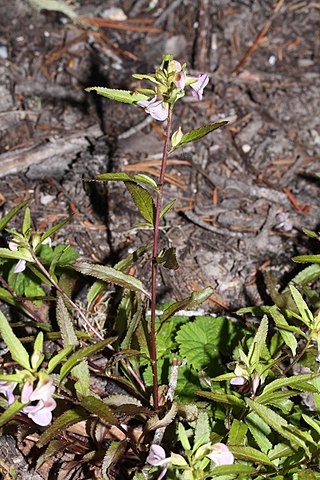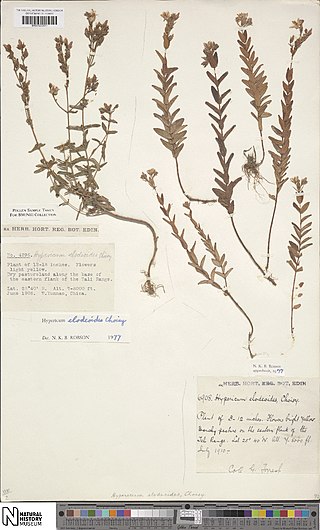
A chandelier is a branched ornamental light fixture designed to be mounted on ceilings or walls. Chandeliers are often ornate, and normally use incandescent light bulbs, though some modern designs also use fluorescent lamps and recently LEDs.

Monotropa uniflora, also known as ghost plant, ghost pipe, or Indian pipe, is an herbaceous perennial flowering plant native to temperate regions of Asia, North America, and northern South America, but with large gaps between areas. The plant is waxy white, but some specimens have been described as having black flecks or pale pink coloration. Rare variants may have a deep red color. The name "Monotropa" is Greek for "one turn" and "uniflora" is Latin for "one flowered" as there is one sharply curved stem for each single flower. M.uniflora is commonly found growing in clumps of 2 or more, with its fungal source nearby.
This page provides a glossary of plant morphology. Botanists and other biologists who study plant morphology use a number of different terms to classify and identify plant organs and parts that can be observed using no more than a handheld magnifying lens. This page provides help in understanding the numerous other pages describing plants by their various taxa. The accompanying page—Plant morphology—provides an overview of the science of the external form of plants. There is also an alphabetical list: Glossary of botanical terms. In contrast, this page deals with botanical terms in a systematic manner, with some illustrations, and organized by plant anatomy and function in plant physiology.

Pectocarya is a plant genus of about 15 species in the family Boraginaceae. Plants in this genus are known generally as combseeds. They are small annual plants which bear tiny white flowers no more than 3 millimeters in diameter. Their fruits are nutlets which often have small projections that look like the teeth of a comb, hence their common name. The nutlets usually come in clusters of four. These plants are found mainly in western North America.

Metroxylon sagu, the true sago palm, is a species of palm in the genus Metroxylon, native to tropical southeastern Asia. The tree is a major source of sago starch.

Juncus ensifolius is a species of rush known by the common names swordleaf rush, sword-leaved rush, and three-stamened rush. It is native to much of western North America from Alaska to central Mexico, and into eastern Canada. It is present in Japan and far eastern Russia, and it has been introduced to many other regions of the world, including Europe, New Zealand, Hawaii, and Australia. It is a plant of wet areas in many types of habitat. This is a rhizomatous perennial herb forming clumps of stems 20 to 60 centimeters tall. The flat but curving leaves are mostly located at the base of the stems and are variable in length. The inflorescence is an array of many rounded clusters of many flowers each. Each flower has a number of dark brown to black tepals a few millimeters long and usually three small stamens enclosed between them. The fruit is an oblong capsule with a small beak on the tip.
This glossary of botanical terms is a list of definitions of terms and concepts relevant to botany and plants in general. Terms of plant morphology are included here as well as at the more specific Glossary of plant morphology and Glossary of leaf morphology. For other related terms, see Glossary of phytopathology, Glossary of lichen terms, and List of Latin and Greek words commonly used in systematic names.

Astragalus acutirostris is a species of milkvetch known by the common name sharpkeel milkvetch. It is native to the Mojave Desert and surroundings of California, Nevada, and Arizona, where it grows in dry, sandy, gravelly areas.

Astragalus layneae is a species of milkvetch known by the common name widow's milkvetch. It is native to the Mojave Desert and surrounding mountain ridges in California and Nevada.
Juncus kelloggii is a species of rush known by the common name Kellogg's dwarf rush. It is native to western North America from British Columbia to California, where it grows in low, wet spots in meadows and other grassy areas, for example, vernal pools.
Pectocarya heterocarpa is a species of flowering plant in the borage family known by the common names chuckwalla combseed and mixed-nut pectocarya. It is native to the southwestern United States and northern Mexico, where it grows in desert, mountain and plateau habitat, in scrub, woodland, and open areas. This is an annual herb producing a slender, rough-haired stem prostrate or upright to a maximum length of about 25 centimeters. The small, pointed linear leaves are alternately arranged, widely spaced along the stem. The inflorescence is a series of flowers, each on a curved pedicel. The flower has small green sepals and tiny white petals. The fruit is an array of four nutlets each lined with comblike prickles.

Pectocarya penicillata is a species of flowering plant in the borage family known by the common names sleeping combseed, shortleaf combseed, winged combseed and northern pectocarya. It is native to much of western North America from British Columbia to Wyoming to Baja California, where it grows in many types of habitat, including disturbed areas such as roadsides. This is an annual herb producing a slender, rough-haired stem, mostly decumbent in form, to a maximum length of about 25 centimeters. The small, pointed linear leaves are alternately arranged, widely spaced along the stem. The inflorescence is a series of flowers, each on a curved pedicel. The flower has small green sepals and tiny white petals. The fruit is an array of four nutlets each lined with comblike prickles.
Pectocarya peninsularis is a species of flowering plant in the borage family known by the common names Baja pectocarya and peninsular pectocarya. It is native to the Sonoran Desert of California and Baja California, where it grows in open desert habitat, including disturbed areas. This is an annual herb producing a slender, rough-haired stem, decumbent or upright form to a maximum length of about 24 centimeters. The small, pointed linear leaves are alternately arranged, widely spaced along the stem. The inflorescence is a series of flowers, each on a curved pedicel. The flower has small green sepals and tiny white petals. The fruit is an array of four nutlets each lined with comblike prickles, those higher on the plant arranged in pairs and the lower ones unpaired.

Pectocarya platycarpa is a species of flowering plant in the borage family known by the common names broadfruit combseed and wide-toothed pectocarya. It is native to the southwestern United States and northwestern Mexico, where it grows in many types of coastal and inland habitat, from mountains to desert. This is an annual herb producing a slender, rough-haired stem, generally upright to erect in form to a maximum height of 25 centimeters. The small, pointed linear leaves are alternately arranged, widely spaced along the stem. The inflorescence is a series of flowers, each on a curved pedicel. The flower has small green sepals and a tiny white corolla. The fruit is an array of four flattened, slightly curving nutlets lined with thin teeth.

Pectocarya pusilla is a species of flowering plant in the borage family known by the common names little combseed and little pectocarya. It is native to the west coast of the United States from Washington to central California, where it grows in several habitat types, including disturbed areas such as roadsides. This is an annual herb producing a slender, rough-haired stem, generally upright to erect in form to a maximum height of about 38 centimeters. The small, pointed linear leaves are alternately arranged higher on the stem, and those lower on the stem are oppositely arranged and fused at the bases. The inflorescence is a series of flowers, each on a curved pedicel. The flower has small green sepals with short hooked hairs and a rounded white corolla. The fruit is an array of four flattened nutlets with fringes of comblike hairs.

Pectocarya setosa, known by the common names moth combseed and round-nut pectocarya, is a species of flowering plant in the borage family.

Pedicularis racemosa is a species of flowering plant in the family Orobanchaceae known by the common names sickletop lousewort and leafy lousewort. It is native to western North America, where it grows in coniferous forests. This is a perennial herb producing several stems up to 80 centimetres (31 in) tall, greenish to dark red in color. The leaves are up to 10 centimetres (4 in) long, linear in shape and lined with teeth. The inflorescence is a small raceme of flowers occupying the top of the stem. Each white to light purple or yellow flower is up to 1.6 centimetres long and is divided into a curved or coiled beak-like upper lip and a wide three-lobed lower lip. The fruit is a capsule over a centimeter in length containing smooth seeds.

Plagiobothrys fulvus is a species of flowering plant in the borage family known by the common names field popcornflower or fulvous popcornflower. It is native to California and Oregon in the United States, as well as Chile.

Veronica anagallis-aquatica is a species of flowering plant in the family Plantaginaceae known by the common names water speedwell, blue water-speedwell,brook pimpernel, and sessile water-speedwell. It is also listed as Veronica catenata. Its true native range is not clear, but the plant is present on most continents, and in most places it is probably naturalized. It occurs in many types of moist and wet habitat, and it is semi-aquatic, often growing in shallow water along streambanks, in ponds, and in other wetland environments. It is a rhizomatous perennial herb with stems growing 10 centimeters to about a meter in maximum length. It may be decumbent, the stem spreading along the ground and rooting where it touches moist substrate, or erect in form. The oppositely arranged leaves are green, smooth-edged or toothed, and sometimes clasping the stem where the leaf pairs meet at the bases. The inflorescence is a raceme of many flowers arising from the leaf axils. Each flower is borne on a short, curving pedicel. The flower corolla is up to a centimeter wide with four lobes, the upper lobe being widest. It is blue, lavender, or violet with purple lines near the base of each lobe. At the center are two small protruding stamens.

Hypericum elodeoides, commonly called the Himalayan St. John's Wort, is a species of flowering plant of the St. John's wort family (Hypericaceae).















